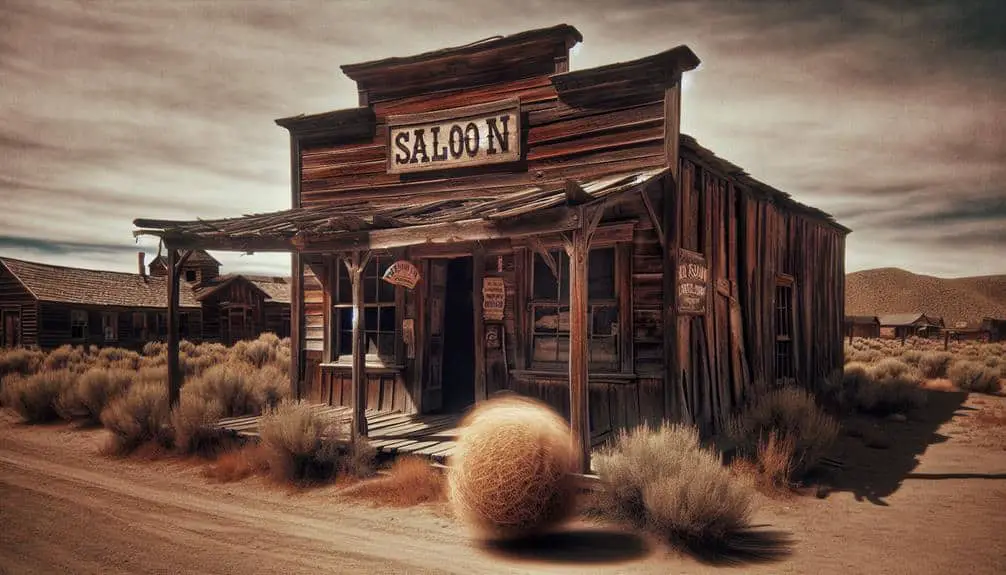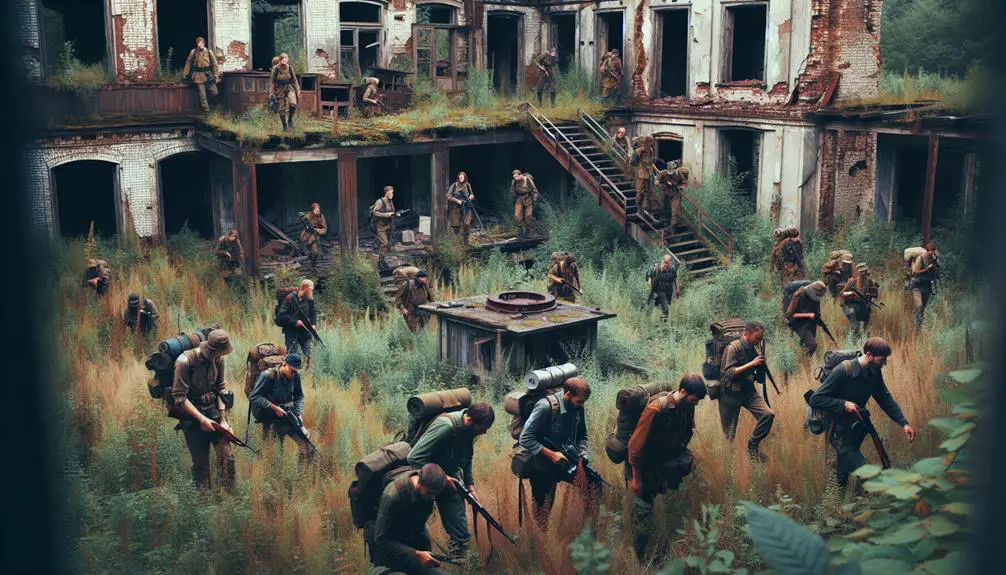Explore the eerie remnants of Civil War era ghost towns across the US, frozen in time and echoing the past war's haunting memories. From desolate streets to silent witnesses of ravaged structures, each holds the importance of history. Uncover personal artifacts revealing daily lives, weapons reflecting conflict, and letters shedding light on town life. Visit abandoned churches and cemeteries with weathered facades and worn tombstones, essential for historical preservation. Discover battlefields turned silent memorials, honoring valor and sacrifice. Preservation plays a crucial role in safeguarding these echoes of the past, ensuring future generations grasp the cost of freedom.
Key Points
- Abandoned buildings frozen in time from Civil War era.
- Artifacts revealing daily life during the war.
- Desolate churches and cemeteries with historical significance.
- Battlefields transformed into silent memorials of valor.
- Preservation efforts essential for future generations' education.
Haunting Structures Left Behind
In these abandoned ghost towns from the Civil War era, haunting structures stand frozen in time, telling stories of a bygone era of conflict and hardship. Eerie ruins dot the landscape, their crumbling facades whispering tales of the past. As you wander through these desolate streets, you can almost feel the weight of history pressing down on you.
The buildings, once bustling with life, now stand as silent witnesses to the ravages of war. Broken windows peer out like empty eyes, while doors creak open on rusty hinges, inviting you to step into the past. Mysterious spirits seem to linger in the air, their presence palpable in the stillness of the surroundings.
Each structure holds a piece of the puzzle, a fragment of the stories that unfolded within their walls. From the abandoned homes of families torn apart by conflict to the decaying remains of once-thriving businesses, these ghostly remnants offer a poignant reminder of the price of war. As you explore these haunting structures, you can't help but wonder about the lives that once inhabited these now-empty shells.
Artifacts Tell Stories of Past
Artifacts within these Civil War era ghost towns serve as tangible relics, narrating poignant tales of a tumultuous past. As you explore these abandoned sites, each historical relic you encounter reveals forgotten tales that offer a glimpse into the lives of those who once inhabited these now desolate lands. Here's what these artifacts can disclose:
- Personal Belongings: Everyday items such as rusted pocket watches, delicate jewelry, and worn-out shoes provide insight into the daily lives of the people who once called these ghost towns home.
- Weapons and Ammunition: Bullet casings, musket balls, and fragments of weaponry speak of the violence and conflict that ravaged these communities during the Civil War era.
- Letters and Documents: Yellowed parchments, faded letters, and official documents shed light on the correspondence, legal matters, and personal relationships that were integral to these towns.
- Household Items: Broken pottery, cooking utensils, and furniture remnants offer a glimpse into the domestic routines and social structures that existed before these towns fell into disrepair.
Each artifact tells a story, preserving the memory of a bygone era and honoring the resilience of those who lived through challenging times.
Abandoned Churches and Cemeteries
Amidst the silent remnants of Civil War era ghost towns in the US, the abandoned churches and cemeteries stand as solemn witnesses to a past marked by turmoil and loss. These structures, once vibrant centers of community life, now echo with the whispers of history. The abandoned churches, with their weathered facades and crumbling walls, hold within them stories of faith, hope, and despair. Their peeling paint and broken pews speak of a time long gone, yet still reverberating through the silent halls.
Adjacent to these churches lie the abandoned cemeteries, where weathered tombstones bear the names of those who once walked the streets of these ghost towns. The gravestones, worn by time and neglect, carry a spiritual significance, honoring the lives of those who found their final resting place among the ruins.
Preserving these abandoned churches and cemeteries is essential for historical preservation, as they offer a glimpse into the past and serve as reminders of the sacrifices made during the Civil War era. Their silent presence calls for reflection and remembrance, urging us to honor the legacy of those who came before us.
Battlefields Turned Silent Memorials
Silently etched into the landscape, the battlefields of the Civil War era have transformed into poignant memorials, preserving the echoes of conflict and sacrifice for generations to come. As you walk through these hallowed grounds, you can almost hear the whispers of forgotten sacrifices and feel the presence of lost souls. The solemn reflections inspired by these sites offer a glimpse into the turmoil and valor of those who fought bravely during one of the darkest periods in American history.
- Fields of Honor: Each acre bears witness to the valor and bloodshed that once soaked the earth.
- Monuments of Remembrance: Statues and markers stand as silent sentinels, honoring the courage and resilience of those who stood their ground.
- Nature's Reclamation: Despite the scars of war, nature has woven its beauty into these landscapes, reminding us of the enduring cycle of life.
- Lessons in Legacy: These battlefields serve as classrooms without walls, teaching us about the cost of freedom and the importance of unity in times of division.
Preserving History for Future Generations
Preservation efforts play an essential role in safeguarding the rich historical tapestry for future generations, ensuring that the legacy of the past remains vivid and accessible.
In the context of Civil War era ghost towns, preserving history involves not only physical conservation but also innovative methods like digital preservation and interactive exhibits.
Digital preservation allows for the documentation and storage of historical artifacts, documents, and stories in a format that transcends time, making them easily accessible to a global audience.
Interactive exhibits bring history to life, engaging visitors of all ages in immersive experiences that foster a deeper understanding of the past.
Frequently Asked Questions
How Do Local Communities Feel About the Presence of Ghost Towns in Their Area?
You can understand local communities' mixed feelings about ghost towns. They hold historical significance but may struggle economically. Some residents champion preservation efforts, valuing the past. Others see them as reminders of loss, sparking varied emotions.
Are There Any Reported Paranormal Activities or Ghost Sightings in These Civil War Era Ghost Towns?
Curious about the eerie tales surrounding Civil War-era ghost towns? Paranormal investigations reveal chilling encounters. Ghost tours offer glimpses of haunted legends. Supernatural encounters make these remnants alive with history, whispering secrets from the past.
What Efforts Are Being Made to Document and Preserve Oral Histories From Residents of These Abandoned Towns?
To document and preserve oral histories from residents of abandoned towns, efforts focus on community engagement. The rich storytelling tradition and cultural heritage are crucial. It's essential to capture these narratives for future generations.
Have Any Archaeological Excavations Been Conducted in These Ghost Towns to Uncover More About Their Past?
Explore the depths of forgotten streets, where time whispers through crumbling bricks. Archaeological findings unearth the past, preserving the historical significance of these ghost towns. Research uncovers tales long buried in shadows.
Are There Any Plans to Develop These Ghost Towns Into Tourist Attractions or Historical Sites in the Future?
You should consider the economic opportunities and tourism potential of developing these ghost towns into historical sites. Engaging the community in preservation efforts can help create sustainable attractions that honor the past while benefiting the present.



